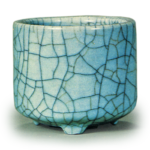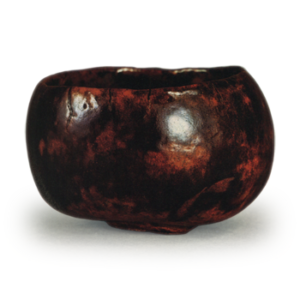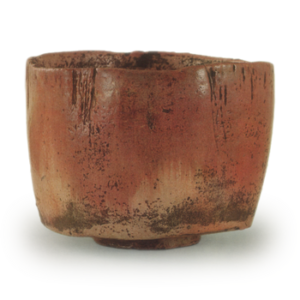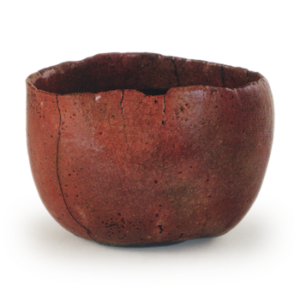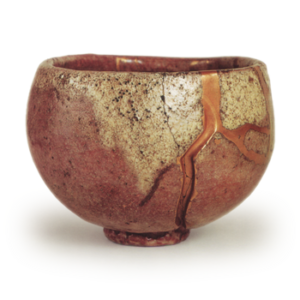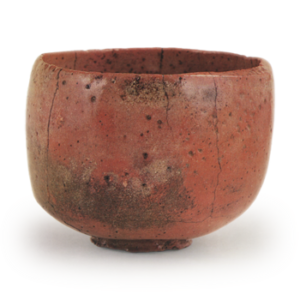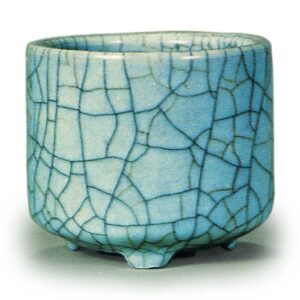
A celadon kiln from the Southern Song dynasty of China, one of the most famous in antiquity. It has been one of the most famous since ancient times, but there are still many problems in determining its provenance. The common theory is that it was the kiln of the elder of the Zhang brothers, Zhang Sheng I, which was located in Liuda at the foot of Liuhua Mountain in Longquan County during the Southern Song dynasty, but there is another theory. In the “Geko Yoron” (Ancient Essays on the Precepts), it is written, “It is from the old Gede. The color is blue, and there are different shades of blue. The color is blue, and the shade is not uniform.
There are few now. There is a Seiguntai, which was newly fired at the end of the Yuan dynasty. The clay veins are rough, and the color is not red. It is said that there is probably a omission under “Kyu Gede”. In the “Shunpudo Essay,” there is the following: “A shallow white Gage kiln with a broken pattern is called “Hyakkakusha. In the Song dynasty (960-1279), there were two brothers, both of whom were from the province of Zhuozhou, and both were masters of the Ryutian kiln in Longquan. The celadon produced by these two brothers is pure and beautiful, and is highly prized by the world. In other words, it is a type of official kiln. The celadon produced by Seiichi is pale in color. In the “Zunsheng 8san,” it is written, “The quality of the official kilns is generally the same as that of the Gage kilns. So-called “official” kilns are fired by the local government officials and made for their families. It is located under Phoenix Mountain in Hangang. The clay is purple, so the color of the foot is like iron. The mouth of a vase is sometimes called a “purple mouth” because the water flows down the upper part of the vessel, and the body is relatively shallow. Therefore, the mouth reveals a faint purple mark. What is so precious about this?
The iron feet of a smoker and a magistrate are all that is needed. If you use clay from elsewhere, it will not be as good as this. Gage kilns are fired in private houses, but the clay is taken from this place. The quality of the kiln is like a crab claw, and the quality of the Gagama kiln is like a fish. The quality of the Gage kiln is like that of a crab claw, while the quality of the Gage kiln is like that of a fish. However, the juice is not as good as that of the Guan kiln,” and in the Milia Histories, “The Gage kiln and Longquan kiln all come from Longquan County in Tao. During the Southern Song dynasty, there were two brothers who each had one kiln. Each of them was in charge of one kiln. The first one to make pottery was the elder brother. The one who made the second potter’s stone was called Longquan. It is named after the name of the place. The color of all of them is blue, and there is no one shade of blue. Its feet are all iron, and there is not a single shade of iron. The purple legs we heard about in the past are now rarely seen. Only those with thin clay veins and pure oil and water are most precious. The Gage kiln has many broken patterns, and it is called “Hyakkakusha. In the “Illustrated Catalogue of Famous Porcelains of All Ages” by Huang Zijing, only one piece, the Wufeng Inkstone Mountains of the Song Gage ware, is recorded, with the following note: “The inkstone mountains follow the pattern of the Han copper mountains, and their height and width are as shown. The four sides of the mountain grove are covered with mountains, and the mountains are set off by the brush strokes of Huang Zi Kuoha. The color is a powder blue, and the ice pattern is broken into small pieces. It should be made as the place of the tax palanquin of Chusho-kun.
I saw it in the house of Yao Taisyu in my hometown. There are many contradictory points in the above description of the Ming people alone, and since the Gwe kiln was already considered a rare and rare artifact at the beginning of the Ming dynasty, it is difficult to trust the later descriptions. There is a theory that Beijin called Tianzhi Gaojun, and that the Gage kiln means the official kiln and refers to the new official kiln under the suburban platform, but this is a truly colorful new theory, and in fact, relics from the new official kiln under the suburban platform are generally called the Gage kiln today. It is a new theory that is in agreement with the artifacts and ancient records, such as the iron foot on the mouth, which is one of the characteristics of the Gayao, and the condition of the open pieces, which are described as “broken with a hundred pieces of broken text,” but it is difficult to understand why only the suburban new official kilns are called Gayao. In addition, the Zunsheng Bakki states that “Gage kilns are fired in private houses,” clearly indicating that they are not official kilns, and in particular, the Shunpudang Essay and the Milia Historic Compendium state that they are “mainly from the Ryuta kiln in Longquan,” and “from Longquan County in Dazhou,” indicating that the kiln is located in Ryuta. This new theory requires further study. Chen Wanli pointed out in the “Weekly Report of the Institute of Language and History of National Zhongshan University, Volumes 4 and 48” that the kiln site of the Gue kiln was the large kiln in Longquan County. Chen Wanli does not give any reason for this, but Ozaki Awamori, in his article “Shiji of Longquan County,” Vol. 1, “Liuhuashan is located in the southern part of the prefecture, 70 li away from the county, and is also known as Xianshan. At the top of the mountain are the remains of a hermit and an iron incense burner. The residents of the mountain are engaged in the pottery business. According to Chen Wanli’s research report, there are more than ten kiln sites in the vicinity of the large kiln, and it is unclear which of them are Gue kilns and which are Chang kilns. Manzo Nakao wrote a series of articles entitled “Kiln sites and celadon of the official kilns (Shunaiji kiln)” in the magazine “Daijyo” (March-November 1930), and in the August issue he wrote a detailed article on the Geki kiln in particular. Please refer to the article “Incense burners and other items from the Geki kiln” in “Ceramics” Vol. 5, No. 5 by Ozaki Shunsheng.

